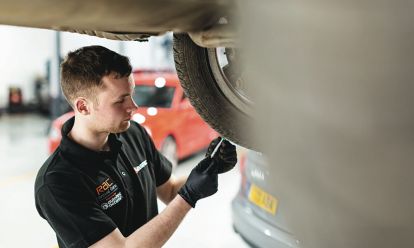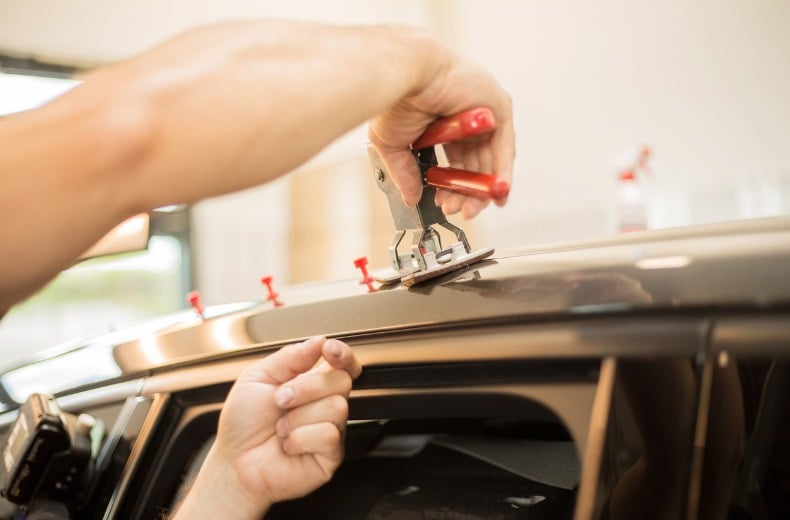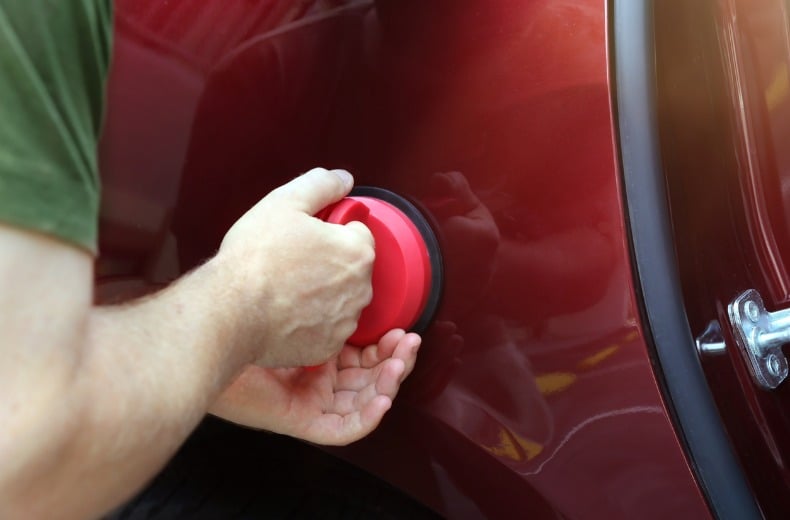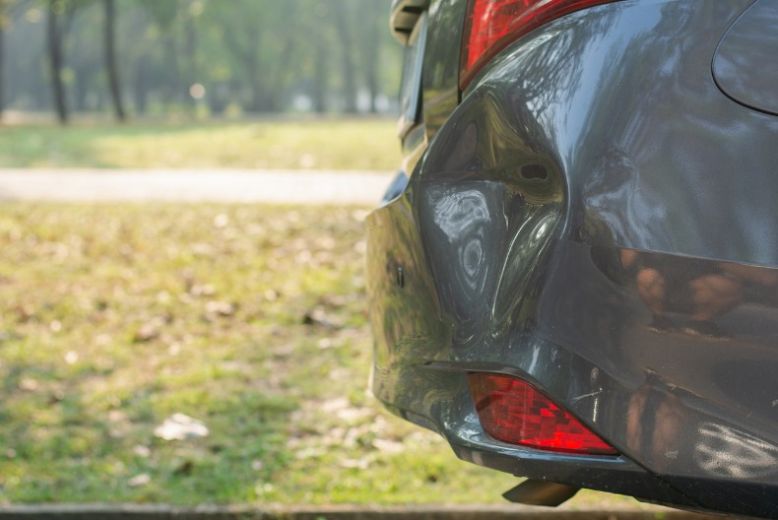Read on to discover how to remove dents and bumps to your bodywork.
Are there common dent locations?
Although dents can occur anywhere on your car's bodywork, some areas are more prone to prangs than others.
If you want to check your car for any irregularities, pay close attention to:
- doors – It’s easy to swing doors open into closely parked cars or other obstructions when you’re not paying attention. Make sure you check all the way to the bottom of the door where high kerbs might have left a mark.
- bumpers – Designed to minimise the impact of collisions, bumpers are one of the first places affected by motoring mishaps. Take a look at the front and back of your car for any dents that might need work.
How much do dent repairs cost?
Repair costs depend on a number of factors:
- the size and depth of a dent
- its location on the panel
- the make and model of the car
- access to the back of the dent (areas obstructed by crash bars and other parts will need more time to fix)
Repairing damage yourself may work out cheaper but should only be undertaken if you’re confident about taking on the task.
If repairs aren’t possible or they work out too expensive, you might want to consider buying replacement parts. In most cases, it's best to visit a trustworthy garage to assess if the damage can be fixed.
Check out our range of car services which include dent repair, scratch repair and more. We can even send out mobile mechanics to do repairs on your driveway.
Service, repair or MOT?
You can trust the RAC with our local approved garages and NEW mobile mechanics.


Can I repair a dent myself?

Yes, but you’ll need to make sure that the damage isn’t too extensive first.
Measure the dent and check that it’s no bigger than three inches in diameter and that it’s shallow, too. If the mark appears on a curve or a contour in the bodywork, a DIY approach probably isn’t the best idea. You’ll also need to be confident about working on your car and accessing the back of panels.
Now it’s time to choose your method. Our step-by-step guides below highlight some of the best ways to get the job done.
If you find the idea of a DIY fix too complicated, a body shop or RAC approved garage will be able to help.
Remember, damage to the paintwork will have to be repaired separately.
How to repair a dent with a hair dryer
Hair dryers may be better suited to salons than garages, but with the right technique you might be able to save cash on bodywork repairs.
Once you’ve assessed the damage and decided you’re confident about repairing the dent yourself, you’ll need a few things:
- a clean soft cloth
- a can of compressed air
- a hair dryer
- insulated gloves
Step one – Ensure you can access both sides of the dent. This could mean opening the bonnet or reaching underneath the car.
Step two – It’s time to plug in the hair dryer. Hold it between five and seven inches away from the affected area on a medium heat setting. After two minutes the panel should be malleable enough to move on to the next step.
Step three - Pull your gloves on and gently press the edges of the dent to test for movement. If the panel feels stiff return to step two and use the hair dryer for another minute or so.
Step four – While still wearing your gloves, take the can of compressed air and give it a good shake. Turn it upside down and spray at the dent. It should take no more than a minute for the dent to pop back into shape.
Step five – Take your cloth and wipe any liquid residue away. Job done.
Top tip: If this method doesn’t work as planned, you can repeat the steps for better results. Try leaving a day between exposing your car to extreme temperature changes.
How to repair a dent with a plunger
It may look hopeful rather than practical, but with the right approach a plunger can provide enough suction for dents to pop out of place.
Be warned, this method should only be used on plastic parts of your car.
You’ll need:
- the plunger
- boiling water
- a clean soft cloth
- insulated gloves
Step one – Pour the boiling water over the dented area. This will soften the surface and make it more malleable.
Step two – Place the plunger over the dent, ensuring it’s fixed into an air-tight position and pull.
Step three – If the dent hasn’t popped out of place try pushing it from behind, while wearing gloves.
Step four – The damage should have disappeared thanks to your plunging and pushing efforts. Simply wipe the surface dry with your cloth.
Top tip: If you need to repeat the steps again try waiting 24 hours before exposing your car to extreme temperature changes.
How to repair a dent with a vacuum cleaner
This method relies on the power of suction and is best used on flat surfaces to help create an airtight vacuum.
You’ll need
- a bowl or bucket with a small hole in the bottom
- a powerful vacuum cleaner
Step one – Cover the whole of the dent with the top of your bucket or bowl in the same way you would do with a plunger.
Step two – Use your vacuum cleaner to cover the hole in the bucket/bowl and turn it on.
Step three – Listen out for a pop confirming that your bodywork has returned to its proper position.
Top tip: A powerful vacuum cleaner could make all the difference. Try hiring a professional model if your everyday appliance isn’t up to the task.

Cheaper than AA or we’ll beat by 20%^
• Roadside cover from £5.49 a month*
• We get to most breakdowns in 60 mins or less
• Our patrols fix 4/5 breakdowns on the spot

How to repair a dent with dry ice
This method uses extreme changes in temperature and you’ll need to wear protective gloves.
You’ll need:
- aluminium foil
- dry ice
- a hair dryer
- insulated gloves
- masking tape
Start by repeating steps one and two from the hair dryer method above.
Step three – Fix aluminium foil over the dent using masking tape to protect your paintwork.
Step four – While wearing heavy-duty gloves, pick up a block of dry ice and rub it across the foil. You should hear the panel pop back into place in less than a minute.
Step five – Remove the foil and marvel at your handywork.
How to repair a dent with glue and wood
If you want to fix a larger or oddly-shaped dent, it could be time to draw for the glue gun. This method is effectively about creating handles to pull the dent out of place.
You’ll need:
- wooden dowels
- screws
- a glue gun
- a drill
Step one – Test the glue gun on an inconspicuous area of your car to check if it won’t damage your paintwork.
Step two – Take the wooden dowels and drill two screws at one end and at either side of the cylinder-shape to create handles. You’ll need one ‘handle’ per square inch of the damage.
Step three – Heat the glue gun and apply the adhesive to the end of the dowels without screws. Fix your customised dowels on and around the dent so they appear once every square inch.
Step four – Leave for 10 mins to dry. You might want to use your trusted hairdryer at this point.
Step five – Pull the handles outwards and the dent should follow. Repeat the steps if necessary and experiment with placing the dowels in different positions.
Step six – Remove the dowels and wash away any leftover glue.
Top tip: Try fixing the dowels to the edges of the damaged area first before working your way into the middle of the dent.
How to repair a dent with a repair kit

Buying tools specially made for the job might be the most effective approach of them all.
There are three main types of dent repair kits:
- Pulling – These kits use the same principle as the wooden dowel technique and work by gluing tabs to the dent and pulling.
- Tapping – Some kits use metal pens designed to tap the dent out of your bodywork. They usually come with a range of heads to fix all kinds of damage.
- Pushing – Alternatively, you could pick up tools designed to push dents outwards from the back of a panel. The kits usually supply different-sized rods but they don’t come cheap.
It’s important to read the instructions provided and if you don’t feel confident about taking on the job you can always contact an RAC approved garage for help.
How to fix a dent on a door panel
Car door panels are typically thinner than other parts of your car. This makes them easier to dent but they are easier to remove for repairs.
Use a screwdriver to detach any wiring or control panels in arm rests, you’ll probably need to pop open screw covers to unfasten everything.
When you pull the door panel away, try to keep the plastic sheet from the door frame completely flat. That way it can be used again.
Once the panel has been removed, try pushing the dent from behind to pop your bodywork back into its rightful place.
Should I repair a dent myself?
The decision to repair a dent yourself depends on a combination of things:
- Extent of damage – small dings should be easy enough to fix yourself but more extensive damage will probably need the help of an expert.
- Budget – rates for bodywork specialists greatly vary, in fact, you could pay between well oer £100 an hour for their help.
- Confidence – even the simplest repair job can seem out of the question if you’re not comfortable making repairs yourself, in which case you should arrange for professional help.
- Time – sourcing all the tools and materials can take a while, especially if you shop around for the best deal. That’s before you’ve even started to master the techniques for a high-quality repair job.
If you’re unsure about how to do the job yourself, an RAC approved garage will be happy to help restore your car where possible. We've got plenty of other car servicing, repair and maintenance products too.
Get 30 driving tips that will save you money
Running a car isn’t cheap, but there are some easy things you can do to keep your costs down. Get these tips and more useful driving articles sent straight to your inbox now.


At what point is it worth claiming on car insurance?
This is a personal choice. If you think you can fix the issue for a nominal fee, then that can be a good option. If there are many issues, then it may be worth claiming on your car insurance.
There are pros and cons for claiming on your insurance, but it is up to you to weigh up the options.
Can you claim for dents on car insurance?
It is important to know that if you have fully comprehensive car insurance with your provider, then your policy should cover scratches and dents on your vehicle.













